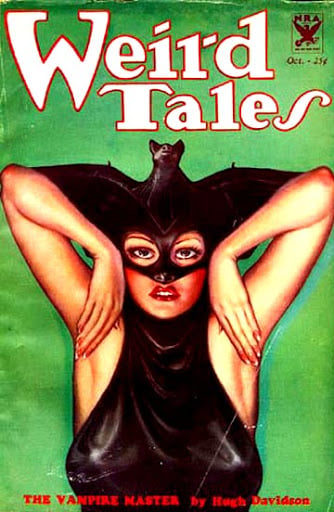
The pulp art that graced the covers of horror serials and B-movie posters during the first half of the twentieth century is now some of the most celebrated and coveted art of the period. The works, by artists such as Virgil Finlay, Edd Cartier, and Norman Saunders, are epics of monstrous proportions depicting candid, lurid snap-shots of often erotic terror. Sometimes painted on gigantic canvases, this art and these artists were horribly unappreciated at the time, dismissed as trashy and subversive by the general public.
The cover art served as the primary means of marketing for pulp magazines, with the visual art on the outside being much more of a draw than the written content inside. The best illustrators became as popular if not more so than the most well-known pulp storytellers and the cover art could be the driving force behind a particular issue -- covers were so important to sales that they would oftentimes be created first, with the authors then asked to write a corresponding story.

The artists, like the writers, created works at a break-neck pace, working on tight deadlines and taking on several projects at once to make a decent living. Famed author Upton Sinclair, before he became a celebrated novelist, wrote for the pulps and would churn out 8,000 words a day, 7 days a week; famed pulp illustrator Saunders would crank out several large oil paintings for covers a day, an extraordinary rate considering the dynamic depth and quality of his work. The pulp art that constituted the covers for horror serials is celebrated today for its deep colors, stark depictions of base human emotion, and dangerous attraction.
So dangerous, in fact, that it was simply not considered art at the time of its publication. The general public, though many enjoyed the illustrations and stories, saw the cover art as a cheap thrill at best. At worst, the more conservative members of society saw the pieces meant to shock and intrigue as "offensive art," of being too erotic to the point of perversion and of being frivolous yet dangerous portrayals of death in motion. Artists were ashamed of their works, and Saunders himself often signed his "proper" artistic endeavors under a different last name. After a new owner bought Street & Smith, a publisher of several popular pulp magazines, and moved offices only to find the company cramped for space, he asked the artists if they wanted any of their original works. All declined. The owner then held a small auction; no bidders. After offering the works for free to his employees, who unanimously refused, the paintings were put on the street to be collected on the next garbage day.

Those paintings now fetch a pretty penny at auction today, the very best and most sought after upwards of tens of thousands of dollars. The works are so valuable in part due to their rareness -- because of incidents like that at Street & Smith, not many originals still exist -- and in large part due to the recognition of their artistic quality in light of the pop-art of Andy Warhol, Ray Lichtenstein, and the like paying homage to these underappreciated artists. Their art is still striking, still dynamic and deep and lurid and enchanting, and is an essential cornerstone not just of the horror genre but of Americana at large.
--Joseph Gustav
(The Black Glove wishes to thank Joseph Gustav, who is a guest blogger for My Dog Ate My Blog and a writer on online schools for Guide to Online Schools.)
